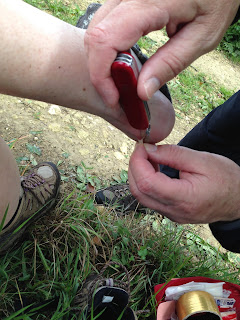A seaside resort city, Brighton features an amusement park on the pier, which opened in 1899. It is advisable to wear a hat due to many circling seagulls.
An attempt at a selfie with the pier and the groyne.
The doughnut groyne is a groyne (a water current-interrupting wharf-like structure) with a big doughnut statue on it. Quite curious.
Noting two things, the tall ride (think flying sauce moving up a very tall column) and Laurel's toned calves. (Andrew wrote this one!)
The Royal Pavilion looks like Aladdin should be flying from it on a magic carpet. It was begun in 1787 as a royal summer dwelling.
There were creative buskers in Brighton, this one dressed as a zebra playing the piano. He was quite talented and had quite an audience.
Due to slight misinterpretation of the map, we took the scenic route to the coastal trail.
You can just see the glow of the cliffs in the distance. I wonder if the innumerable sheep enjoy the view?
This is what we came to see!
Well worth the slow bus ride and the warm walk. It was hard to leave.
The coastguard cottages with Laurel contemplating living in an isolated area.
The first of the seven sisters, called Haven Brow, is 253 feet high. Click on the picture to see the people on top.
On the train, heading back to Gatwick, not pregnant, but I think I qualified as the guy with the cane?
Perhaps a more literate society, many of the ads in the train stations were for newly published novels.
A few observations as I close off this trip blog. This vacation was wonderful, rating as one of the top 3 trips I've taken with Andrew. The daily challenge of walking 8 to 14 miles and reaching your next destination (and luggage) was very satisfying and the overall accomplishment of completing the 100 miles of trail was so rewarding. It certainly wasn't easy and I know I would never attempt it by myself, but after the second day, we just knew what we had to do and did it.
Some things that are different in Britain than in Canada - they don't have facecloths, which kind of makes sense (less laundry), the majority of places we stayed did not have an upper sheet on the bed, just a sheet over the mattress and a duvet (again less laundry, but not sure about this!). Their public transit is affordable and very efficient. They could use some refinement on their currency (the 50 pound note was too wide for my wallet) and the tuppence seems a bit redundant.
The Cotswold Way was an experience that was well worth the time and effort it took to plan and execute. The National Trust historic sites along the path were fascinating. The Cotswold Way is one of the 15 National Trails and as such is well marked and maintained. In Britain there are many public footpaths maintained for the enjoyment of all and I wonder if we should be taking note here in Canada and developing similar trails.
Thank you to all who have been reading along - cheerio for now!
























































